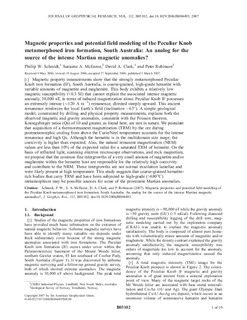Magnetic properties and potential field modeling of the Peculiar Knob metamorphosed iron formation, South Australia: An analog for the source of the intense Martian magnetic anomalies?
Journal article, Peer reviewed
Published version
Permanent lenke
http://hdl.handle.net/11250/2491918Utgivelsesdato
2007Metadata
Vis full innførselSamlinger
Originalversjon
Journal of Geophysical Research - Solid Earth. 2007, 112 (B03). 10.1029/2006JB004495Sammendrag
[1] Magnetic property measurements show that the strongly metamorphosed Peculiar Knob iron formation (IF), South Australia, is coarse‐grained, high‐grade hematite with variable amounts of magnetite and maghemite. This body exhibits a relatively low magnetic susceptibility (<0.3 SI) that cannot explain the associated intense magnetic anomaly, 30,000 nT, in terms of induced magnetization alone. Peculiar Knob IF possesses an extremely intense (∼120 A m−1) remanence, directed steeply upward. This ancient remanence reinforces the local Earth's field (inclination −63°). A simple geological model, constrained by drilling and physical property measurements, explains both the observed magnetic and gravity anomalies, consistent with the Poisson theorem. Koenigsberger ratios (Qs) of 10 and greater, as found here, are rare in nature. We postulate that acquisition of a thermoremanent magnetization (TRM) by the ore during postmetamorphic cooling from above the Curie/Néel temperature accounts for the intense remanence and high Qs. Although the hematite is in the multidomain size range, the coercivity is higher than expected. Also, the natural remanent magnetization (NRM) values are less than 10% of the expected value for a saturated TRM of hematite. On the basis of reflected light, scanning electron microscope observations, and rock magnetism, we propose that the common fine intergrowths of a very small amount of magnetite and/or maghemite within the hematite host are responsible for the relatively high coercivity and contribute to the NRM. These intergrowths are not normal exsolution lamellae and were likely present at high temperature. This study suggests that coarse‐grained hematite‐rich bodies that carry TRM and have been subjected to high‐grade (>680°C) metamorphism may be possible sources for some of the prominent Martian anomalies.
